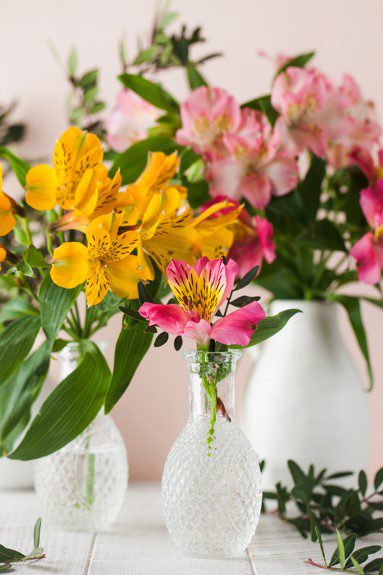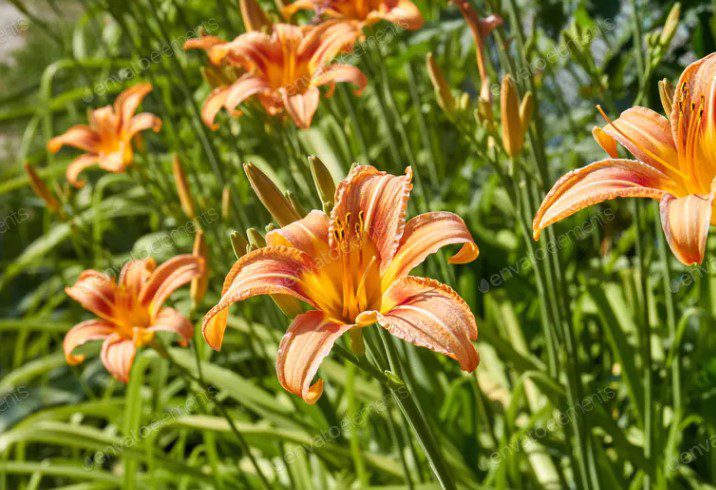Alstroemeria
Alstroemeria is commonly referred to as the Peruvian Lily or St. Martin’s flower. They were named after Klas Alstroemer, who introduced these plants into cultivation in Europe in 1754. Once considered a subdivision of the Liliaceae, Alstroemeriaceae is recognized as a distinct family of four genera and about 150 species.
Alstroemeria is a fleshy-rooted, herbaceous perennial, sometimes with rhizome-like tubers, forming clumps up to one meter across. It may take two to five years to mature and produces erect stems bearing lanced-shaped leaves narrowly from mid-to-grey-green.
In summer, it produces umbels of showy, funnel-shaped flowers.
Alstroemeria is ideal for mixed or herbaceous borders. It should be grown in well-drained, fertilized soil in the sun or partial shade. Mulching for the first two years greatly improves performance.
Alstroemeria is found throughout Chile and to some extent in Brazil. The genus varies greatly in both the range of flower colors and habitats within a limited area.
Species grow from the Pacific coast of Chile to the Andes and from the Atacam desert to the temperate cloud forests of the country’s south.
Alstroemeria is late flowering, with some species flowering well into the summer, mostly from June to November. Alstroemeria aurea, Alstroemeria ligtu, and hybrids make good garden plants, but many are best grown in cool bulb frames or raised beds.
Alstroemeria Care
For Alstroemeria species, seeds should be sown in the autumn, with germination occurring between 5° and 10°C. Large clumps can be divided into autumn or very early spring.
The genus contains a compound that can cause dermatitis and skin irritations.
Alstroemeria is an important cut-flower crop with worldwide production. Vegetatively propagated material contains many poorly characterized viruses.

There are several certification schemes to improve the overall quality of Alstmemeria, and standardized methods of diagnosis and detection are now used in breeding programs to test germplasm before it is used.
Meristem-tip culture techniques have been developed to provide virus-free cultivars. Horticulture Research International has worked on carlaviruses and cucumber mosaic viruses in Alstmemeria.
Alstroemeria should be grown in any fertile, free-draining, but moisture-retentive soil in sun or partial shade. It spreads freely, employing fleshy roots.
Pests
Botrytis can attack the genus, but good husbandry, appropriate spacing, and good ventilation help avoid the problem. Removing and destroying all infected material and spraying with a preventive fungicide can help.
Alstroemeria can be susceptible to snails, slugs, caterpillars, and aphids.
Pest control using the standard methods is advisable.
Varieties
There are 16 colors available for Princess Lilies, ranging from pink, yellow, and white to red. Theresa (the top), Letizia (the bottom), and Eliane are the most popular. All varieties can reach 16 inches in height without using PGRs.
The flower formation is negatively affected by PGRs. Tissue-culture-propagated plants are delivered in 50-cell liners from various locations. Ball Seed and Fred C. Gloeckner sell liners.
Growing in Pots
The most common size pots are 8-inch, but you can use 6- to 10-inch pots. Only one plug should be used per container.
The plug will eventually fill the entire pot. You should plant the top of the plug just below the soil surface.
You can use a mixture of coarse-grained peat and peat-coconut fiber (60 percent/40%)
Princess Lilies are heavy feeders. The pH recommendation is between 6.0 and 6.5.
It is recommended to use a base fertilizer of 0.6 EC or a slow-release fertilizer. Use only clean water for two weeks after planting.
After week three, increase fertilizer use. Use water with an EC below 1.5 mS [N–K ratio: 2-1]. Once the plant has set roots, you can increase the EC to 2.0 mS.
Temperature
To develop a strong root system, start at 60°F for three weeks. Ideal temperatures are 50°F to 55 deg F after the start.
Over 75°F in the greenhouse can delay flower initiation and cause blind shoots.























